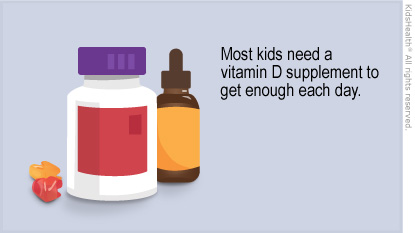Vitamin D is a nutrient that supports bone health, the immune (germ-fighting) system, and overall growth and development.
The body gets vitamin D (also called vitamin D3) from the diet and can also make vitamin D when sunlight reaches the skin. Even with a healthy diet, it's not always easy to get enough vitamin D. If needed, your healthcare providers may recommend that your child take a vitamin D supplement (sometimes labeled vitamin D3). You can buy vitamin D pills, gummies, chewables, oral (by mouth) drops, and sprays in drugstores without a prescription.


Vitamin D for Babies
Babies under 1 year need 400 IU (international units) of vitamin D each day. Breast milk is best for babies, but it doesn't have enough vitamin D. Give babies who drink breast milk vitamin D drops or a multivitamin drop that contains vitamin D as recommended by your healthcare provider. Formula has vitamin D added. Babies who drink 32 ounces (about a liter) or more of formula each day don't need a vitamin D supplement.
Vitamin D for Kids and Teens


What foods have vitamin D? Very few foods have vitamin D naturally. The foods with the most vitamin D are fish (such as salmon and tuna), liver, eggs, and cod liver oil. Most kids don't eat a lot of these foods. That's why food companies add vitamin D to milk, yogurt, baby formula, juice, cereal, and other foods. Adding vitamin D to foods is called "fortifying." This is helpful, but it still may not be enough.
How do I know if my child is getting enough vitamin D? Talk to your healthcare provider about how much vitamin D your child is getting. They may recommend vitamin D supplements, diet changes, or that your child spend a few minutes in the sun every day if they think your child isn't getting enough of the vitamins and minerals they need. If needed, your healthcare provider may order a blood test.
What happens if kids have low vitamin D levels? Very low vitamin D levels in growing children can lead to rickets. A child with rickets can have poor growth, bowed legs, and slowed development. Older kids with very low levels of vitamin D can get osteomalacia (softening of the bones). Doctors think that even levels that are only slightly low could lead to weaker bones.
Besides diet and sun exposure, what else affects vitamin D levels? Things that can affect vitamin D levels include:
What about calcium? Vitamin D helps the body absorb calcium. Unlike with vitamin D, kids usually can get enough calcium from food. High-calcium foods include milk, cheese, and yogurt. Food products, such as cereal, bread, or juice, are often fortified with calcium.